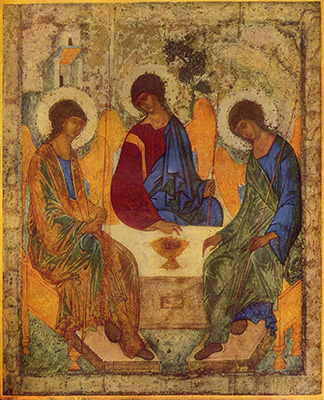Readings: Exodus 34: 4–6, 8–9; Daniel 3: 52–56; 2 Corinthians 13:11–13; John 3:16–18
 My parents, who were born in Ireland, looked forward each year to the arrival of a small box from the “old country” that contained fresh shamrock for St. Patrick’s Day. My mom always took the opportunity to explain how St. Patrick used the three-leafed plant as a symbol of the Trinity and a practical tool to teach the Irish people about this vital aspect of their faith.
My parents, who were born in Ireland, looked forward each year to the arrival of a small box from the “old country” that contained fresh shamrock for St. Patrick’s Day. My mom always took the opportunity to explain how St. Patrick used the three-leafed plant as a symbol of the Trinity and a practical tool to teach the Irish people about this vital aspect of their faith.
Many years later, in a theology class, other students and I were invited to create a personal symbol of the Trinity, that is, a presentation of the great mystery, one God and three persons. The root, the stem, and the flower, the three-sided isosceles triangle, the smoothie, and even a woman pregnant with twins were just a few of the symbolic depictions made by the students.
However, the question lingered for each of us. Can the symbol help us to believe? Does it capture the height and depth and width and length of our God? In the reading from Exodus today, Moses speaks with God in a very personal and intimate way. He acknowledges God as a loving father who is slow to anger and rich in kindness and fidelity. Then he invites God to come along with his “stiff-necked” companions. Could it be that belief comes more from personal interaction than it does through any artistic or symbolic depiction?
During the current coronavirus crisis, we hear “God” referenced broadly by health care workers, television reporters, those grieving, the jobless, politicians, and those living in fear. Their invitation to God was, “O God, stay with us, protect us, help us to get through this because we are afraid.” Even some proclaimed atheists slipped into the language of belief amid this terrible unfamiliar threat. We call on God in our need, and God dwells with us.
One symptom of the COVID-19 virus is the growing sensation that “I cannot breathe.” The recent troublesome actions of a police officer who continued to deprive a restrained man of breath while he gasped, “I can’t breathe,” has wreaked havoc across the nation. Each day protests, as well as violence and looting, seem to escalate.
In today’s liturgy, the reading from Corinthians echoes the guidance offered to generations of families and communities during stressful times. “Mend your ways, encourage one another, live in peace.” These words are for justice seekers and those who strive to live justly. The message is for parents who are working at home and may feel frustrated while trying to monitor children’s schoolwork. Those who find it oppressive to observe quarantine, use face masks, and limit movements are painfully aware of their newly experienced limitations. They may even doubt the effectiveness of these measures.
In our current circumstances, the end is not in sight, and that fact in itself is distressing to people who are accustomed to quick solutions. The news of the daily death toll from the virus and of violent demonstrations continues to shock us. We are keenly aware that people of color, those who are homeless, hungry, or disabled, seem to be at a significant disadvantage in this crisis, and it is difficult to provide them with the help they need. As racial tension and disease mounts in our cities, we desperately need to call on the power of the Trinity to open the floodgates of love and unity.
The Greek symbol of perichoresis captures the concept of the indwelling of three persons in the triune God, Father, Son, and Spirit. Perichoresis depicts the Trinity in a perfectly harmonious dance where there is mutual giving and receiving, a relationship best described as love. The interaction between the three persons of the Trinity is expressed as dynamic, interactive, loving, and serving. As Christians, we join in this harmonious dance, especially through the mysteries of the incarnation, death, and resurrection of Jesus.
We know —and have experienced— the love of our God, a love that is gratuitous and does not depend on our effort. Jesus, who is our friend, our redeemer, our savior, is with us always to show us the way. The Holy Spirit almost imperceptibly fills us, guides us, and nourishes us with goodness.
The closing paragraph of the selection from Corinthians captures the essence of our God as Trinity, three persons in relationship. “The grace of the Lord Jesus Christ and the love of God and the fellowship of the Holy Spirit be with all of you.” As we celebrate the Feast of the Trinity, we can be assured that the symbol, the dance, the triune prayer, and even suffering all have the potential of nurturing community and unity in the challenging days ahead.
– Sheila Brosnan, SC
 Sr. Sheila, a Councilor on the Congregation’s leadership team, formerly served as Vice-President – Mission Integration for ArchCare, the health care ministry of the Archdiocese of New York. She also served in teaching, nursing, missionary work in Chile and Guatemala and parish pastoral ministry.
Sr. Sheila, a Councilor on the Congregation’s leadership team, formerly served as Vice-President – Mission Integration for ArchCare, the health care ministry of the Archdiocese of New York. She also served in teaching, nursing, missionary work in Chile and Guatemala and parish pastoral ministry.

Dear Sister
Thank you for your words of hope. I am reminded this day of my communion with creation. In this little plot of earth God has blessed me with, I grow. In my years. Through my faith, I pray in my love for our Creator, the gift of His Son, the Word of the Holy Spirit, that the gift of life I am blessed with may be a blessing to others
Beautifully insightful reflection on an infinite mystery! An omnipresent God who is imminent while also above us infinitely at all times. A lot to ponder. Thanks, Sr Sheila.
Thank you for helping us to connect this incomprehensible mystery with our present reality.
Well said, Sheila! Thank you!
Thank you Sister. Your words help to illustrate the goings on in our world today..We are faced with pain and fear that are difficult to see beyond..